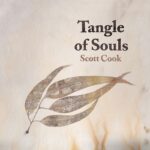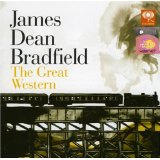 The last album from Scott Cook to hit my inbox was 2016’s “Go Long”, which shone a beam on the more light-hearted side of Scott’s songwriting. He described it as ‘a bunch of silly songs’, which didn’t entirely do it justice, because it had its serious moments and it was actually a great bunch of songs, whatever the flavour. “Tangle of Souls” is a very different proposition; it was written following a brush with the reaper and reflects the re-evaluation following that experience as well as other, happier, life events. Also, Scott Cook’s a philosopher and an idealist; it shouldn’t be surprising that there’s a sprinkling of social comment on the album as well. There are a lot of targets out there in 2020 and Scott firmly sets his sights on quite a few of them.
The last album from Scott Cook to hit my inbox was 2016’s “Go Long”, which shone a beam on the more light-hearted side of Scott’s songwriting. He described it as ‘a bunch of silly songs’, which didn’t entirely do it justice, because it had its serious moments and it was actually a great bunch of songs, whatever the flavour. “Tangle of Souls” is a very different proposition; it was written following a brush with the reaper and reflects the re-evaluation following that experience as well as other, happier, life events. Also, Scott Cook’s a philosopher and an idealist; it shouldn’t be surprising that there’s a sprinkling of social comment on the album as well. There are a lot of targets out there in 2020 and Scott firmly sets his sights on quite a few of them.
Let’s just take a step away from this particular album for the moment to look at albums in general. There’s a school of thought that the album is dead (particularly in CD form) and that a series of singles is the best way to capitalise on your work. Which might work if you rely on streaming or downloads for income; for artists who tour a lot in smaller venues an album or EP to sell at the merch desk is a great way to generate income without the hassle of distribution. What Scott has done with this album (and, to a lesser extent 2017’s “Further Down the Line”) is to go back to an earlier time when the music was only part of the album-buying experience. If you’re of a certain vintage, you’ll remember buying the album and checking out the artwork, credits, sleeve notes and lyric sheets, probably on the bus home. It built up the anticipation before you got the chance to play the album. What Scott’s done with “Tangle of Souls” takes this a few stages further. The album includes a two hundred and forty-page booklet which includes credits, lyrics, chords for the songs, the inspiration behind, and explanation of the songs and some of Scott’s biographical, historical and philosophical writings. It’s even printed on specialist paper with hand-drawn artwork. That’s got to be better than a thumbnail of the artist as you listen to a stream or a download (and yes, I did read all of it, it would have been rude not to).
So to the songs. There are twelve of them and each one of them is memorable, and several of them, for me, are classics. “Just Enough Empties” contrasts a gentler, not-too-distant past, with a lonely and alienated present through one person’s journey down a road of innocence, awakening, degradation and redemption linked by the practical idea of glass bottle recycling; it’s a beautifully-crafted song. “Say Can You See”, with the obvious reference to the “Star-Spangled Banner” in the title, is built around a string band arrangement and is Scott’s most overtly political song so far. It’s political, but in a non-partisan way; the message is that virtually everyone on the Hill (Republican or Democrat) is the enemy of the working people and that draining the swamp should actually flush away all of them (‘It ain’t about right and left, it’s about right and wrong’). Those two songs alone would make this a five-star album for me, but there’s even more.
“Passin’ Through” was written by Dick Blakeslee in the forties and it’s one of those songs that lends itself to verses being changed or added. The narrative structure could have inspired the Stones’ “Sympathy for the Devil”; Jagger says it was something from Rabelais, but he would say that, wouldn’t he? Scott adds his own verse to the song with a tribute to Victor Jara, the Chilean activist beaten and executed by Pinochet’s thugs in the Santiago Estadio Nacional in 1973. This song attracted my attention even more because, coincidentally, the Manic Street Preachers’ James Dean Bradfield has recently released an entire album dedicated to Victor Jara (“Even in Exile”). It’s worth checking that out as well.
The last of my personal picks is “What to Keep”, a slow piece that interweaves the personal and political in an exploration of the physical and mental baggage that we carry with us as individuals or as nations. The message is that there are always things that weigh us down that we should cut loose to lighten our load, whether it’s personal memorabilia or inappropriate public commemorations of bygone eras; the less you carry, the easier it is to move forward. The remaining seven songs and one instrumental are all superbly crafted and delivered, and packed with interesting and thought-provoking ideas, but I’d like you to listen to some of the album without the dubious benefit of my opinion.
“Tangle of Souls” is an important work from the wider Americana scene this year. It’s a deeply-considered view of individuals and society twenty years into the twenty-first century; the narratives aren’t necessarily cheerful, but the overall message is positive, in line with Scott’s personal outlook after some challenging times (which you can read about in the book).
“Tangle of Souls” is released in the UK on Friday October 9th.
 “Twang”; simple, it does what it says on the tin. OK, front cover, but you know what I mean and, actually, it does quite a lot more than it says on the tin. The twang is certainly present, but there’s a lot more to this album than Dick Dale influences. “Twang” is much more than surf or surf-punk. James Oliver pulls in many more guitar influences including Elmore James, Chuck Berry, Link Wray, Mick Green, Wilko Johnson and George Thorogood. And that’s before we even mention the legendary Dave Edmunds, whose collaborator Paul Riley mixed “Twang”. If you want another Welsh guitar connection, James is from Blackwood, home of the Manic Street Preachers – all part of the service.
“Twang”; simple, it does what it says on the tin. OK, front cover, but you know what I mean and, actually, it does quite a lot more than it says on the tin. The twang is certainly present, but there’s a lot more to this album than Dick Dale influences. “Twang” is much more than surf or surf-punk. James Oliver pulls in many more guitar influences including Elmore James, Chuck Berry, Link Wray, Mick Green, Wilko Johnson and George Thorogood. And that’s before we even mention the legendary Dave Edmunds, whose collaborator Paul Riley mixed “Twang”. If you want another Welsh guitar connection, James is from Blackwood, home of the Manic Street Preachers – all part of the service.
The album’s opener, “American Cars”, is a humorous swipe at the role of the car in rock ‘n’ roll music and the conspicuous absence of the American models in the Welsh Valleys, in a similar vein to Billy Bragg’s “A13, Trunk Road to the Sea”, but with more guitar; loads more guitar and plenty of piano as well. It sets the scene for the album; the musicianship is cracking, it’s one hundred miles per hour and there’s a lot of humour running through it.
Did someone mention Link Wray? The instrumental, “The Missing Link” is the surf equivalent of Stevie Ray Vaughan’s version of “Little Wing” as James runs through the various techniques of surf guitar, demonstrating his complete mastery of the genre (and more besides); and just like SRV’s piece, it’s a masterclass.
There are a couple of Big Joe Turner covers, “TV Mama” and “Honey Hush”, where James pulls in a few other references as well; “TV Mama” hints at Dave Edmunds’ 1970 No. 1 cover of the Dave Bartholomew classic “I Hear You Knocking”, while “Honey Hush” hints at a Phil Spector production, which Dave Edmunds also emulated for a while in the early seventies.
The James Oliver Band is much more than a simplistic tribute to sixties surf music. The stylings are complex; there are multiple tempo and rhythm changes throughout, particularly on “The Missing Link” and “Clean House” and the album’s closer, the Dick Dale classic “Misirlou” winds down with a bottom E string being gradually de-tensioned as the tune winds to a close. These are all examples of a musician with technical expertise and a clinical understanding of how a song is put together.
With the death of Cavan Grogan earlier this, maybe it’s time for James Oliver to make his breakthrough; after all, sixty-five years down the line all Chuck’s children are still out there playing his licks.
“Twang” is out now via The Last Music Company (2REV101).
Here’s a little video clip for you as well:
Ok, NME, you’ve got some explaining to do and, no, it’s not about your obsession with Pete Doherty’s appetite for self-destruction this time. I bought the NME when it was New Musical Express and the emphasis used to be on new. Actually, to be completely fair, it still does new music and too much of it if you ask me. Every week there are at least twenty “great” new bands from around the world featured in “Radar”; that’s a thousand bands a year to feel guilty about not hearing, and that’s not counting the twenty “essential” new tracks featured in “On Repeat”. There is such a thing as too much music. But maybe I just slipped off-topic there for a second.
This might surprise you, coming from a cantankerous old git, but what’s the deal with all the old music in the “New” Musical Express. Apart from the regular features, “Anatomy of an (old) Album”, “Soundtrack of my Life” (old songs) and “This week in …” (old news), the cover features for the last two weeks have been twentieth anniversary pieces on “The Holy Bible” and “Definitely Maybe”. I’m not saying they’re bad albums; they’re not. I parted with my hard-earned for both of them – twenty years ago. So, apart from the front cover, each of these albums gets ten pages in the magazine as well. If you delve further into the back issues, there’s a fairly predictable 100 most influential artists piece (early August) and a Led Zeppelin retrospective (late May).
This is editorial content by focus group and the group must have been fifty per cent Hoxton and Dalston scenesters and fifty per cent old rockers from The Borderline and The 100 Club; sounds like a really bad sixtieth birthday party. So, what’s the target demographic (or whatever the current marketing phrase is for the people you want to buy your product) for big pieces about old music? Is it the Moss-thin, leather shrink-wrapped, pony-tailed Nick Kent wannabe who never stopped reading the New Musical Express, or is it the student who’s waded through all of the new bands and new songs and decided that there’s nothing there worth bothering with and it’s time to start looking back twenty years to find something decent. Can you imagine looking back from 1976 and thinking that you needed to find out a bit more about Pat Boone, Doris Day and Winifred Atwell? Thought not.
So, where do you draw the line? How many more “classic” album anniversaries can we dig out to fill a cover and ten pages that should really be devoted to new music? And what anniversaries do we have lined up over the next few weeks; Crash Test Dummies’ “God Shuffled his Feet”? We could get ten pages out of the (not very) subtle reference to right-wing poster girl Ayn Rand’s novel, “Atlas Shrugged”, and maybe an interview with Neil Peart to pad it out. How about Echobelly’s “Everyone’s Got One”? That got them a whole season on student summer ball circuit before they imploded; should be worth a few pages, and Sonya Madan’s back out there again so she should be happy to get the publicity. Where do you draw the line? Sleeper, Menswear, Lush, Gene? I think you get the picture.
NME, get a grip. If I want to act my musical age, I’ll buy Q or Mojo. Until then, I expect you to tell me about what’s happening now, not twenty years ago.
 Just in case anyone hadn’t realised, I’ve loved the Manics almost from day one. From the first time I heard “Slash ‘n’ Burn”, I was hooked and I’ve never heard anything since that came remotely close to unhooking me. I loved the Richey-period Manics because of Richey’s lyrics and James’s voice, playing and ability to write a memorable tune and I didn’t skip a beat when Nicky Wire took over as main lyricist for the band. He’s a gifted writer and he has an opinion or two; I like that.
Just in case anyone hadn’t realised, I’ve loved the Manics almost from day one. From the first time I heard “Slash ‘n’ Burn”, I was hooked and I’ve never heard anything since that came remotely close to unhooking me. I loved the Richey-period Manics because of Richey’s lyrics and James’s voice, playing and ability to write a memorable tune and I didn’t skip a beat when Nicky Wire took over as main lyricist for the band. He’s a gifted writer and he has an opinion or two; I like that.
So, in 2006, when James Dean Bradfield released his solo album “The Great Western”, I couldn’t wait to get my hands on a copy. I loved it the album the first time I listened to it and I still love it every time I listen to it. The highest chart position it reached (with minimal promotion) was 22, and that puts it firmly in Closet Classic territory. Oh, and my favourite mondegreen is on this album, but I’ll tell you about that later.
So why would a songwriter in a commercially successfully and critically-acclaimed band want to release a solo album? Well, the Manics have always been big on the manifesto songs but, with a few exceptions (including “Life Becoming a Landslide” and “Ocean Spray”), they’ve not really done the personal, apolitical and introspective thing. If you’re a songwriter as prolific as James, you’re always going to have a bunch of great songs that just won’t work on any band album. When you listen to “The Great Western”, you realise that it would be criminal not to get these songs out there.
I love an album that opens with a big guitar riff and “The Great Western” certainly ticks that box; throw in some handclaps as well on the intro to “That’s No Way to Tell a Lie” and you’ve got my attention from the first four bars (it was even used on “Match of the Day”, so full marks to that BBC researcher). The production on the album is generally Spectoresque wall-of-sound, with the exception of the beautiful minimalist acoustic Jacques Brel cover “To See a Friend in Tears” and the final song “Which Way to Kyffin” which references Laurie Anderson’s “O Superman”, and James has great fun with all of the melodic invention, layers of acoustic and electric guitars and completely over-the-top backing vocals that you would never hear on a Manics record (ok, maybe on “Everything Must Go”).
Lyrically, the album generally looks backwards to the early days of the Manics, life in the valleys in the 1980s and moving away from that life. “An English Gentleman” is a tribute to the band’s first publicist, Philip Hall, “Say Hello to The Pope” and “Bad Boys and Painkillers” (the only song on the album co-written with Nicky Wire) look back to life in Blackwood, and “Emigré” deals with the conflict created by leaving your roots to pursue your dreams. “Still a Long Way to Go” sounds a lot like a prequel to the highly personal “Ocean Spray” and “Run Romeo Run” has a chorus to rival anything that made it on to a Manics record.
Anyone with a pair of ears knows that James Dean Bradfield can write a great tune (and you can ask Shirley Bassey about that) but “The Great Western” proves that he’s a gifted lyricist and a talented producer as well. Seven years after I bought this album, I still love to listen to it and I’m convinced that James had a huge amount of fun putting the whole thing together. I suspect it was bought almost exclusively by Manics fans and that’s a bit of a shame really because this is a superb bunch of songs and it’s eclectic, well-crafted, well-performed and well-produced.
And what about that mondegreen? After hearing “On Saturday Morning We will Rule the World” many, many times I was still confused by a line that I heard as “A book of Brie and a telephone” until I finally realised that it was “A Ford Capri and a telephone”, which is ironic given that I’ve spent the last ten years living as an emigré a couple of miles from the old Ford complex in Dagenham.
Even if you’re not a fan of the Manic Street Preachers, put your prejudices to one side and listen to an album that absolutely fizzes with emotion and musical and lyrical invention. What more could you possibly want?


